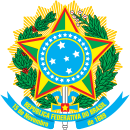 Female police officer at an event in São Paulo in 2004. | |
| General Statistics | |
|---|---|
| Maternal mortality (per 100,000) | 56 |
| Women in parliament | 9.6% (2012) |
| Women over 25 with secondary education | 50.5% (2010) |
| Women in labour force | 59.6% (2011) |
| Gender Inequality Index[1] | |
| Value | 0.390 (2021) |
| Rank | 94th out of 191 |
| Global Gender Gap Index[2] | |
| Value | 0.696 (2022) |
| Rank | 94th out of 146 |
| Part of a series on |
| Women in society |
|---|
 |
| Part of a series on |
| Feminism |
|---|
 |
|
|
| Part of a series on the |
| Culture of Brazil |
|---|
 |
| Society |
| Topics |
| Symbols |
Women's societal roles in Brazil have been heavily impacted by the patriarchal traditions of Iberian culture, which holds women subordinate to men in familial and community relationships.[3] The Iberian Peninsula, which is made up of Spain, Portugal and Andorra, has traditionally been the cultural and military frontier between Christianity and Islam, developing a strong tradition for military conquest and male dominance.[4] Patriarchal traditions were readily transferred from the Iberian Peninsula to Latin America through the encomienda system that fostered economic dependence among women and indigenous peoples in Brazil.[4] As the largest Roman Catholic nation in the world, religion has also had a significant impact on the perception of women in Brazil, though over the past century the Brazilian government has increasingly broken with the Catholic Church in regard to issues related to reproductive rights.
Brazil is considered to possess the most organized and effective women's movement in Latin America, with visible gains having been made over the past century to promote and protect the legal and political rights of women.[5] Despite the gains made in women's rights over the past century, women in Brazil still face significant gender inequality, which is most pronounced in the rural areas of Northeastern Brazil.[6] In 2010, the United Nations ranked Brazil 73rd out of 169 nations based on the Gender Inequality Index, which measure women's disadvantages in the areas of reproductive rights, empowerment and labour force participation.[7]
Women's movements in Brazil have traditionally been led and supported by upper middle class women, and tend to be reformist rather than revolutionary in nature, though clear exceptions exist, most notably with regard to agrarian land reform movements.[8] Though suffrage was granted to women in Brazil in the 1930s, it was not until the 1970s and onwards that a broader, more potent women's movement took hold in Brazil. In 1979, the year of its publishing, Brazil signed and ratified CEDAW, a convention by the United Nations that aims to eliminate all forms of discrimination against women.[9] Women in Brazil enjoy the same legal rights and duties as men, which is clearly expressed in the 5th article of Brazil's 1988 Constitution.[10]
The World Economic Forum released a study indicating that Brazil had virtually eradicated gender differences in education and health treatment, but that women lagged behind in salaries and political influence. According to the Labor and Employment Ministry, women were paid 30 percent less than men. In 2005, UN Special Rapporteur Despouy noted a strikingly low level of women's representation in the judicial system, where women occupied "only 5 percent of the top posts in the judiciary and the Public Prosecutor's Office."[11] Many women have been elected mayors and many women have been federal judges. The first female assumed office in the Senate in 1979. Women became candidates for president for the first time in 1989. As of 2009, 9% of the seats in the national parliament were held by women.[12]
- ^ "Human Development Report 2021/2022" (PDF). HUMAN DEVELOPMENT REPORTS. Retrieved 9 December 2022.
- ^ "Global Gender Gap Report 2022" (PDF). World Economic Forum. Retrieved 24 February 2023.
- ^ Metcalf, Alida C. Women and Means: Women and Family Property in Colonial Brazil, Journal of Social History. Vol. 24, No 2 (Winter 1990) pp. 277–298
- ^ a b Pikerman, Allen (2002). "Early Latin America". International World History Project. Archived from the original on 27 May 2006. Retrieved 6 December 2011.
{{cite web}}: CS1 maint: unfit URL (link) - ^ Fiedler, A. M., & Blanco, R. I. (2006). The Challenge of Varying Perceptions of Sexual Harassment: An International Study. Journal of Behavioral and Applied Management, 7, 274–291
- ^ Caipora (Organization). Women in Brazil. London: Latin American Bureau, 1993. Brazil has come a long way to gain equal rights but there is still much to be done. For instance, they are many women going to universities but still aren't seen equal in the workforce and their isn't many of them seen as managers or executives. Consideration of reports submitted by states parties under article 18 of the Convention on the Elimination of All Forms of Discrimination against Women: combined initial, second, third, fourth and fifth periodic reports of states parties : Brazil. New York: United Nations, 2002
- ^ "Gender Inequality Index". United Nations Development Programme. September 2010. Archived from the original on 13 May 2011. Retrieved 6 December 2011.
- ^ Schmink, Marianne. Women in Brazilian Abertura Politics. Signs. Vol. 7, No. 1 (Autumn, 1981), pp. 115–134
- ^ "Signatory or Ratified in Brazil | impowr.org". www.impowr.org. Retrieved 11 May 2017.
- ^ "Guide to Law Online: Brazil | Law Library of Congress". www.loc.gov. Retrieved 13 August 2019.
- ^ Report on Human Rights Practices 2006: Brazil. United States Bureau of Democracy, Human Rights, and Labor (March 6, 2007). This article incorporates text from this source, which is in the public domain.
- ^ "UNdata". data.un.org. Retrieved 13 August 2019.